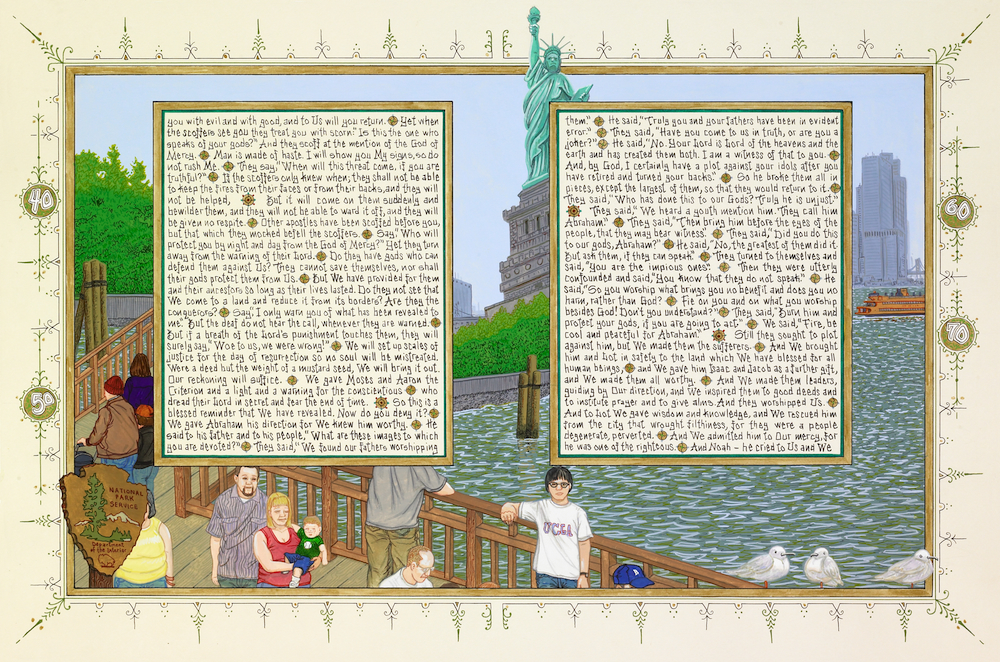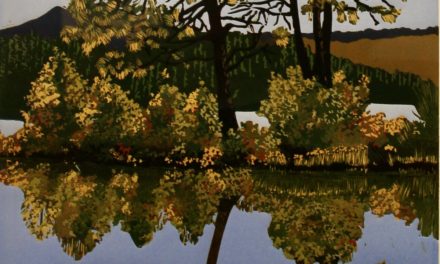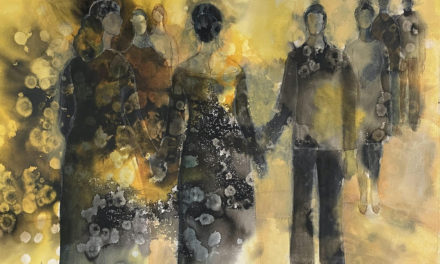By Randi Bjornstad
It’s gorgeous, thought-provoking, weighty — symbolically and literally, weighing in at 12 pounds — and without a doubt, a book called “American Qur’an” should rank as one of the most important and satisfying, not to mention impressive, books that many in this country could hope to read this year.
“American Qur’an” also is the title of a new exhibit opening at the Jordan Schnitzer Museum of Art at the University of Oregon with a public reception on Jan. 20 and a gallery tour with the artist followed by a panel discussion on Jan. 21. The show will be on view through March 19.
It’s the work of artist Sandow Birk, who turns 55 this year and has spent his career visually plumbing the effects of war, propaganda, inner-city violence, politics, graffiti and the meaning of contemporary American life.
But he also has addressed lighter topics, including skateboarding, surfing and other elements of American culture.
This book came out of the darker tradition, following the epic tragedy of Sept. 11, 2001, when Middle Eastern hijackers succeeded in commandeering four commercial aircraft and crashing them into both World Trade Towers in New York City, the Pentagon in Washington, D.C., and a field in Shanksville, Pa. Nearly 3,000 people died, and 6,000 more were injured.
Jill Hartz, executive director of the Schnitzer museum, has followed and admired Birk’s work for many years.
“He embarked on ‘American Qur’an’ because he wanted to learn more about Islam, partly because of the Sept. 11 tragedies and partly because he had always been a surfer and had visited many Muslim countries as he traveled the world, looking for the best waves,” Hartz said. “His work almost always centers on social action projects — he has focused on the depravities of war, the cultures of California prisons and mining disasters. He did a set of wall-sized woodblocks of the Abu Ghraib prison in Iraq.”
Birk’s idea of illustrating the Qur’an was different, however, Hartz said.
“With this project, he wanted to go beyond the fact that the United States has been at war in predominantly Muslim nations for over a decade,” she said. “He wanted to show that the text of the Qur’an contains principles and values that apply to all nations. And he wanted to do it in a way that Americans, who don’t know much about the Qur’an or the Muslim faith, could understand and appreciate it.”
He did it by working with existing, official English translations of the massive text, writing the entirety of the words in a graffiti-like calligraphy and illustrating the pages with artwork that drawls parallels with the American experience.
For example, the text telling of the Annunciation of Mary by the Archangel is portrayed by a pregnant woman receiving an ultrasound. The story of Noah and the Flood is illustrated by a scene representing Hurricane Katrina in New Orleans. The section dealing with resurrection and the afterlife shows doctors resuscitating a patient who has flatlined.

Artist Sandow Birk interprets one section in “Qur’an America” with a picture of a U.S. political convention
Other pages of Qur’anic text are accompanied by pictures of farm workers, governmental services and a political party’s national convention.
Each of the 50 United States is represented somewhere in the book.
The hefty undertaking took Birk a decade, as those familiar with his work waited eagerly for the result.
“We’ve been seeing pieces of ‘American Qur’an’ for the past seven years, and all of us were wondering when it would be ready,” Hartz said. “The book was finally published in 2016.”
In anticipation, it was named one of the best books of 2015 by Publishers Weekly. The volume, which measures 12-by-16 inches, costs $100.
The resulting art exhibit, which consists of hundreds of pages of illustrated text, has not been without controversy.
“The Orange County Museum of Art was the first to show it, and we were going to participate with them in creating a traveling exhibit, but no other museums agreed to pick it up, so it is coming to us next and will be here for two months,” Hartz said.

Many of the Qur’an’s descriptions an admonitions mirror those of other major religions
In addition to nearly 200 of the ink-and-gouache images, the show also will feature two other large paintings, one a Jacques Cousteau-type painting of underwater research and one of a Russian astronaut, Yuri Gagarin.
“The idea is to portray humanity in terms of the depth of the ocean, the depth of space and the depth of the spirit,” Hartz said.
The exhibit also will include ceramic depictions of the mihrab, the semicircular niche that indicates the direction of Mecca and, therefore, the way people of the Muslim faith should face when praying.
 Even so, the overall show should not be considered a religious show, partly because of the English translation of the text of the Qur’an.
Even so, the overall show should not be considered a religious show, partly because of the English translation of the text of the Qur’an.
“To be considered the direct revelation from God, the text must be written in Arabic, which was Mohammed’s language,” Hartz said. “This is an opportunity for people in this country to learn about the verses of the Qur’an in the context of their own lives and culture.”
American Qur’an
When: Through March 19
Where: Jordan Schnitzer Museum of Art, 1430 Johnson Lane, University of Oregon campus
Museum hours: 11 a.m. to 8 p.m. Wednesday, 11 a.m. to 5 p.m. Thursday through Sunday
Information: 541-346-3027 or jsma.uoregon.edu
Special “Amerian Qur’an” events:
* Opening public reception — 6 p.m. to 8 p.m. on Jan. 20 (free admission all day)
* Gallery tour with artist Sandow Birk — 1 p.m. on Jan. 21
* Panel discussion, “Whose Qur’an?” — 2 p.m. on Jan. 21
* Sandow Birk’s “American Qur’an: A New Dawn for the Koran” — 5:30 p.m. on Feb. 2; lecture by Bruce Lawrence, professor emeritus of Islamic Studies at Duke University and adjunct professor at the Fatih Sultan Mehmet Vakf University in Istanbul, Turkey
* Dancing in Damascus: Creativity, Resilience, and the Syrian Revolution — 3:30 p.m. on Feb. 3; lecture by Miriam Cooke, professor of Arab Cultures, Asian & Middle Eastern Studies at Duke University, with book signing at 3 p.m.
* Who is Allah? — 7:30 p.m. on Feb. 6, Reading Room, 175 Lillis Hall; lecture by Bruce Lawrence
* Aesthetic Dimensions of Sandow Birk’s “American Qur’an Project — 5:30 p.m. on Feb. 10; lecture by Iftikhar Dadi, associate professor in Department of History of Art at Cornell University
*Arab Refugees in Our Midst: Terrorism, Bigotry, and Freedom — 2 p.m. on Feb. 11; Oregon Humanities Conversation with Yasmeen Hanoosh, professor of humanities at Portland State University.
* Whose America? Stories of Immigration, Citizenship, and Religion — 5:30 p.m. on March 1; panel discussion moderated by Chris Chavez of the UO School of Journalism and Communication
* Artist’s Lecture by Sandow Birk — 6 p.m. on March 9, 177 Lawrence Hall, UO campus
* Sandow Birk: “American Qur’an” — 5:30 p.m. on March 10; lecture by Zareena Grewal, associate professor of American Studies and Religious Studies at Yale University, followed by conversation with Sandow Birk









